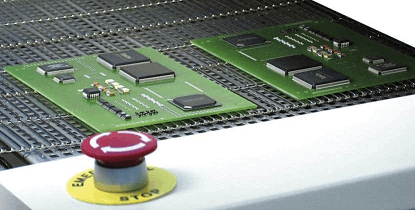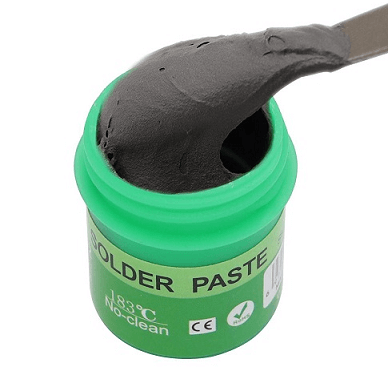Reflow soldering is a process in which solder paste is applied to the contact pads of a PCB, place the components on and melt the solder paste to join the electrical components. The solder “reflows” to make the connection.
The reflow soldering technique resembles the traditional soldering process in many ways. But, the one major difference is that it uses heated air to melt the solder instead of a soldering iron.
The entire assembly is passed through a reflow oven that has an infrared lamp (or convection or a combination of both). The lamp heats the air that melts the solder and joins the electrical components.
Besides, you can control the temperature of the infrared lamp. So, you can heat the board gradually to ensure that it does not break due to thermal shock.
A sudden rise in temperature is known as thermal shock. Thermal shock weakens the joints and causes them to break easily. This can be prevented by using the reflow soldering technique.
The following article explains the process of reflow soldering, its pros, and the different stages involved in it.
What is Reflow Soldering?
As mentioned already, an infrared lamp is used to heat the air and melt the solder in the reflow soldering technique. The board is passed through a tunnel or reflow oven where it is heated in a controlled manner.
In this, you apply the solder paste only over the areas (contact pads) where you want to assemble the electronic components.
The reflow soldering process produces reliable joints that are solid. Since they do not undergo any thermal shock, the joints are strong. Besides, they require minimal monitoring, and the process is conducted in controlled conditions.
The reflow soldering technique is ideal for soldering surface mount components. It is most commonly used for assembling PCBs in mass production.
Pros of Reflow Soldering
- It is preferable for SMT assembly
- It produces only a less thermal shock
- It is one of the most reliable soldering technique
- It has options for limited soldering
- It requires only a minimum level of monitoring
- It leads to less wastage
- It can be used to solder specific parts of a PCB
Preparation
There are two main steps involved in the reflow soldering process of PCB. The first is to apply the solder paste and the second is to assemble the components.
Solder Paste
Before applying the solder paste, you have to use a stencil to ensure the solder is applied only to the areas where the copper pads will be installed. If you do not use the stencil properly, it will lead to the formation of solder bridges.
By using the stencil, you can apply the solder paste only on the areas in PCB where soldering is needed.
Pick and Place
Once you have applied the solder, then you can assemble the components on the board. If the number of components is less, you can manually assemble the components.
But if the components are more or if you are soldering on a commercial level, then it is best to use a pick and place machine.
With the pick and place machine, you can place the components on the board automatically. The components will be held onto the board by the surface tension of the solder paste.
But in some cases, you have to apply glue to ensure the components do not fall off from the board. If you apply glue, it will be difficult to rework the PCB.
Once you have placed the components on the board, then you can move them to the reflow soldering machine.
Reflow Soldering Stage
The reflow soldering process consists of several stages to ensure the joints are strong. The temperature of the board is gradually increased before the soldering process to prevent thermal shocks.
The four different stages of the reflow soldering process are as follows,
Preheat
You have to heat the board slowly to bring it up to the required temperature. If you subject the board to rapid heating, it will lead to thermal shock and break the board.
Besides, if the heating is not stable, it will cause hot and cool spots on the board. Some parts of the board will have a higher temperature. And, some parts of the board will have a lower temperature.
For infra-red reflow soldering, you have to raise the temperature of the board by 2 to 3°C. In some cases, you can also increase the temperature by 10°C.
Thermal Soak
Once you have brought the board to the required temperature, you have to move it to the thermal soak area. In this, you have to maintain the board at a steady temperature. This will ensure that all areas of the board are brought up to the required temperature.
Additionally, it will also remove the solder paste and activate the flux.
Reflow
In the reflow area, the temperature of the board reaches the highest point. The reflow process melts the solder and fuses the solder joints. The high temperature causes the flux to reduce the surface tension at the joints of the metals causing metallurgical bonding.
This causes the solder powder to combine and melt.
Cooling
Once the solder melts and fuses the joints, you have to allow the board to cool down. You have to make sure that the cooling effect does not cause stress to the components.
Cooling the board prevents thermal shock of the components and excess intermetallic formation. Proper cooling temperature should be in the range of 3 – 10°C. This temperature range creates a fast cooling effect and provides strong joints.
Reflow Ovens
Reflow ovens are large machines that are used to assemble PCBs. These machines provide soldering capability to both small and large PCB assembly areas.
If you are soldering in a small PCB assembly area, then you can buy smaller reflow ovens according to your rework and assembly area. These machines are tailored to suit the needs of small PCB assembly areas.
Frequently Asked Questions
Reflow soldering is a type of soldering technique in which solder paste is applied over copper plates and melted to assemble electrical components on the board. In this, the board is subjected to controlled heat to prevent thermal shock.
The main difference between reflow soldering and wave soldering is the spraying of flux. In wave soldering, you spray flux over the metal before soldering. But, in the case of reflow soldering, you directly apply the solder and start the soldering process.
The solder reflow temperature depends on the solder mixture. For lead-free solder, the typical reflow temperature from 240 to 250°C with 40 to 80 seconds over 220°C. In case these lead-free solders, minor changes in temperatures do not cause any problems in soldering.
Yes, you can reflow solder with a heat gun. But, it is a very time-consuming process. The process won’t be suitable if you have to assemble a large number of electrical components on a board.
Once, you have soldered the joint, allow it to cool for some time. Do not touch the joint using your hand. Use a magnifying glass and inspect the solder joint. The joint should look shiny and fill the copper pad.
Conclusion
The soldering takes place in a tunnel or reflow oven, under controlled heating to prevent thermal shock and strengthen the joints.
If you have any other doubts or queries, let us know using the comments section. Our team of experts will help you out. You can also post your thoughts and opinions in the comments box.





